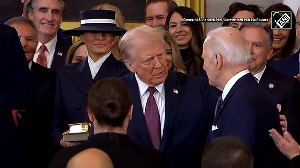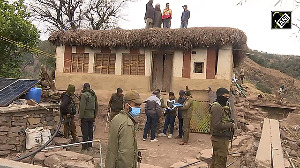
'The supreme art of war is to subdue the enemy without fighting.' Former RA&W official Jayadeva Ranade explains what China's military reforms mean for the world.
Crucial portions of the major military reforms -- described as 'far reaching and unprecedented' -- that were publicly announced on September 3, 2015, by Xi Jinping, who is concurrently the general secretary of the Chinese Communist Party, president of China and chairman of the Central Military Commission, have begun to be implemented.
On December 31, 2015, on the occasion of conferring flags on the newly created People's Liberation Army general command of army, PLA Rocket Force and PLA Strategic Support Force, Xi outlined the direction of the PLA in an official speech known as Xun Ci -- literally translated as 'admonishing words.'
Xi is only the second person to give a Xun Ci since the founding of the People's Republic of China. The other leader to have delivered a Xun Ci to the military in China's 67-year history was Mao Zedong, who did so in 1952 and 1953. Xi's decision to deliver the Xun Ci is a sign of his confidence and that he is consolidating authority to implement the plans for major military reform.
The substantive contours of these reforms are fast becoming clearly visible. On January 1, 2016, the Central Military Commission headed by Xi issued the full text of the 4,993-character Guideline on Deepening National Defence and Military Reform.
The 'guideline' clearly emphasises the political nature of the PLA and its subordinate relationship to the Chinese Communist Party. The central features of these are clearly: Strengthened 'political and ideological education'; expansion of the Chinese Communist Party organisation in the military; thoroughly implementing the resolutions of the Party's 18th Congress and the Third, Fourth and Fifth Plenum, Marxism-Leninism, Mao Zedong Thought, Deng Xiaoping Theory, the important thought of 'Three Represents', the guidance of scientific development concept and the teachings of the chairman's series of important speeches.
The Guideline asserts that the main objective of the reforms is to equip the PLA for 'Theatre battles' -- in other words to replace the existing military regions with theatre commands, establish a joint operational command system and promote the development of military and civilian integration.
It stated that these would be achieved by 2020 along with the capability of 'winning' the information war and effectively carrying out 'mandated missions by a military system with Chinese characteristics.'
The Guideline also disclose that while in 2015 the focus was on organising implementation of the leadership and management system and reforming the joint operational command system, in 2016 the reforms will focus on downsizing the PLA and its organisation, reforming the 'military combat force structure' and institutions, and basically completing the reforms.
The period between 2017 and 2020 is to be devoted to making further adjustments to specific areas of reform and optimising and improving the reforms that have been implemented. Attention will be paid to the development of military and civilian integration.
On January 2, 2016, the state-run Global Times summarised the contents of the 'guideline on deepening national defence and military reform' released by the Central Military Commission on New Year's Day.
It noted that a day earlier, the CMC had announced establishment of the General Command of the Army, the People's Liberation Army Rocket Force and the PLA Strategic Support Force. Justifying the reforms the Global Times observed, briefly: (i) 'China's national interests and current international situation are constantly changing, so is the task of the Chinese army.'
'Hence, the PLA and relevant mechanisms have to be adjusted accordingly to keep up with the pace of China's rise';
(ii) 'the task that confronts China's armed forces is arduous and more than just safeguarding the nation's maritime and land territories.'
'As China's international cooperation grows, more Chinese enterprises go global and the country embraces greater responsibility to maintain regional and world peace, a strong Chinese army is needed';
(iii) 'China must have a strong military... China doesn't need to worry about military aggression.'
'But there is more about national security....During China's rise, friction with the US has gone beyond broad geopolitics. If China has a big gap with the US in terms of military prowess, this will affect its international position and other countries' attitude toward China';
(iv) 'with a strong army, China can be more politically appealing, influential and persuasive, and will make it easier to network.'
'As we gain more trust from other countries, many of them will no longer be dependent on the US for security and on China for economic benefits';
(v) 'moreover, our military strength has to be demonstrated to the world.'
'The army needs to be able to fight battles and provide real deterrence. The supreme art of war is to subdue the enemy without fighting';
On December 31, 2015, at a ceremony in Beijing attended by the entire CMC, Xi conferred military flags to the three new organisations -- the PLA's General Command of the Army, the PLA Rocket Force and the PLA Strategic Support Force.
Xi also announced the names of the commanders and political commissars of the new organisations indicating that they are formal, separate entities.
Generals Li Zuocheng and Liu Lei were appointed commander and political commissar of the PLA's general command of the army, the commander and political commissar of the PLA Rocket Force are General Wei Fenghe and General Wang Jiasheng respectively and General Gao Jin has been appointed commander of the new PLA Strategic Support Force and General Liu Fulian as its political commissar.
Establishment of these organisations, it was stressed, was 'to realise the Chinese dream and the dream of a strong military, and a strategic initiative to build a modern military power system with Chinese characteristics.'
Xi described the PLA Rocket Force as 'China's core strategic deterrence power' and as strengthening nuclear deterrence and nuclear counter-attack capabilities, intensifying the construction of medium and long range precision strike power, and reinforcing the strategic check-and-balance capability.'
He emphasised that the 'PLA Strategic Support Force is a new-type combat force to maintain national security and an important growth point of the PLA's combat capabilities', thus suggesting that its responsibilities would include innovation and missile R&D.
The PLA's general command of the army appears to effectively be the headquarters of the ground forces -- in the last couple of years described in official Chinese documents as the PLA Army, PLAA -- and likely to absorb some of the functions of the erstwhile general political department, general logistics department and the general armaments department.
While the substantive parts of this crucial stage of the military reforms are being implemented fairly rapidly, there is, however, unease in the middle and lower ranks of PLA officers. Indicative are the publication of at least twenty articles relating to the military reforms from September 3, 2015, until now by the official PLA Daily.
Earlier in September, both the vice-chairmen of the CMC travelled to all seven military regions to explain the reforms to the middle and lower ranking PLA officers.
Jayadeva Ranade is a former additional secretary in the Cabinet Secretariat, Government of India, and president of the Centre for China Analysis and Strategy.
IMAGE: China's President Xi Jinping at a military ceremony in Beijing. Photograph: Jason Lee/Reuters











 © 2025
© 2025